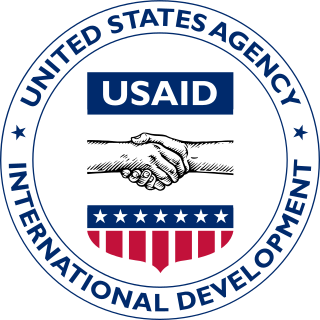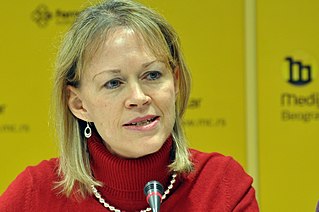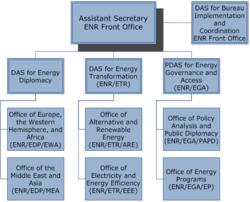
The United States Department of State (DOS), or simply the State Department, is an executive department of the U.S. federal government responsible for the country's foreign policy and relations. Equivalent to the ministry of foreign affairs of other nations, its primary duties are advising the U.S. president on international relations, administering diplomatic missions, negotiating international treaties and agreements, and representing the U.S. at the United Nations. The department is headquartered in the Harry S Truman Building, a few blocks from the White House, in the Foggy Bottom neighborhood of Washington, D.C.; "Foggy Bottom" is thus sometimes used as a metonym.
The United Nations Development Programme (UNDP) is a United Nations agency tasked with helping countries eliminate poverty and achieve sustainable economic growth and human development. The UNDP emphasizes on developing local capacity towards long-term self-sufficiency and prosperity.

The United States Agency for International Development (USAID) is an independent agency of the United States government that is primarily responsible for administering civilian foreign aid and development assistance. With a budget of over $50 billion, USAID is one of the largest official aid agencies in the world and accounts for more than half of all U.S. foreign assistance—the highest in the world in absolute dollar terms.

The Bureau of Intelligence and Research (INR) is an intelligence agency in the United States Department of State. Its central mission is to provide all-source intelligence and analysis in support of U.S. diplomacy and foreign policy. INR is the oldest civilian element of the U.S. Intelligence Community and among the smallest, with roughly 300 personnel. Though lacking the resources and technology of other U.S. intelligence agencies, it is "one of the most highly regarded" for the quality of its work.

The Bureau of International Organization Affairs (IO) is a bureau in the United States Department of State that creates and executes U.S. policy in the United Nations and other international organizations. It is headed by the Assistant Secretary of State for International Organization Affairs. The IO is charged with developing and implementing the policies of the U.S. government with respect to the United Nations and its affiliated agencies, as well as within certain other international organizations. The Bureau of International Organization Affairs was created in order to strengthen the United States involvement in important international relations.
Assistant Secretary of State (A/S) is a title used for many executive positions in the United States Department of State, ranking below the under secretaries. A set of six assistant secretaries reporting to the under secretary for political affairs manage diplomatic missions within their designated geographic regions, plus one assistant secretary dealing with international organizations and one equivalent as the coordinator/ambassador at large for counterterrorism. Assistant secretaries usually manage individual bureaus of the Department of State. When the manager of a bureau or another agency holds a title other than assistant secretary, such as "director", it can be said to be of "assistant secretary equivalent rank". Assistant secretaries typically have a set of deputies, referred to as deputy assistant secretaries (DAS).

In the United States Government, the Bureau of East Asian and Pacific Affairs is part of the United States Department of State and is charged with advising the Secretary of State and Under Secretary of State for Political Affairs on matters of the Asia-Pacific region, as well as dealing with U.S. foreign policy and U.S. relations with countries in the region. It is headed by the Assistant Secretary of State for East Asian and Pacific Affairs, who reports to the Under Secretary of State for Political Affairs.

In the United States Government, the Bureau of European and Eurasian Affairs (EUR) is part of the United States Department of State, charged with implementing U.S. foreign policy and promoting U.S. interests in Europe and Eurasia, as well as advising the Under Secretary of State for Political Affairs. It is headed by the Assistant Secretary of State for European and Eurasian Affairs.

In the United States government, the Bureau of Western Hemisphere Affairs (WHA) is a part of the U.S. Department of State, charged with implementing U.S. foreign policy and promoting U.S. interests in the Western Hemisphere, as well as advising the Under Secretary of State for Political Affairs. It is headed by the Assistant Secretary of State for Western Hemisphere Affairs, who is currently Brian A. Nichols.

The Under Secretary for Economic Growth, Energy, and the Environment is an undersecretary position within the United States Department of State. The Under Secretary for Economic Growth, Energy, and the Environment serves as senior economic advisor at the State Department and advises the Secretary of State on international economic policy and is often referred to as the senior economic diplomat of the United States. The Under Secretary also leads the work of the department on trade, agriculture, aviation, and bilateral trade relations with America's economic partners.

The Bureau of South and Central Asian Affairs (SCA) is an agency within the United States Department of State that is responsible for the U.S. government's relations with countries in the South and Central Asian region. The bureau is headed by the Assistant Secretary of State for South and Central Asian Affairs, who reports to the Secretary of State through the Under Secretary of State for Political Affairs. The current Assistant Secretary is Donald Lu, incumbent since September 15, 2021.

The Bureau of Near Eastern Affairs (NEA), also known as the Bureau of Near East Asian Affairs, is an agency of the Department of State within the United States government that deals with U.S. foreign policy and diplomatic relations with the nations of the Near East. It is headed by the Assistant Secretary of State for Near Eastern Affairs, who reports to the Under Secretary of State for Political Affairs.

The Bureau of International Security and Nonproliferation (ISN) is a bureau within the United States Department of State responsible for managing a broad range of nonproliferation and counterproliferation functions. The bureau leads U.S. efforts to prevent the spread of weapons of mass destruction, their delivery systems, advanced conventional weapons, and related materials, technologies, and expertise.

The U.S. Department of State's Bureau of International Information Programs (IIP) supported the department's public diplomacy efforts by providing and supporting the places, content, and infrastructure needed for "sustained conversations" with foreign audiences. It was headed by the Coordinator for International Information Programs. IIP was one of three bureaus that reported to the Undersecretary for Public Diplomacy and Public Affairs. The Bureau of Educational and Cultural Affairs and the Bureau of Public Affairs were its sister bureaus. On May 28, 2019, IIP merged with the Bureau of Public Affairs into the Bureau of Global Public Affairs, and the duties of IIP Coordinator merged into the duties of the Assistant Secretary of State for Global Public Affairs.

The Quadrennial Diplomacy and Development Review (QDDR) is a study by the United States Department of State, conducted beginning in 2009 and intended to be done every four years, that analyzes the short-, medium-, and long-term blueprint for the United States' diplomatic and development efforts abroad. It seeks to plan on a longer-term basis than the usual year-to-year, appropriations-based practice, and to integrate diplomacy and development missions. It similarly seeks to correlate the department’s missions with its capacities and identify shortfalls in resourcing. Finally, it is a precursor to core institutional reforms and corrective changes. The first review was completed by the end of 2010. A second review began during 2014 and was released in April 2015. No further reviews have taken place.

Patricia Marie Haslach is an American diplomat. She served as the Acting Assistant Secretary of State for Economic and Business Affairs, from January 2017 to September 2017. She previously served as the United States Ambassador to Ethiopia from August 4, 2013 through September 2016.

Mary Burce Warlick is an Australian-born, American diplomat who was appointed Deputy Executive Director of the International Energy Agency in May 2021. A former United States career diplomat, she served as the United States Ambassador to Serbia from January 2010 to September 2012, as the U.S. Consul General in Melbourne, Australia from October 2012 to July 2014, as Principal Deputy Assistant Secretary in the Bureau of Energy Resources at the Department of State from August 2014 to September 2017, and as Acting Special Envoy and Coordinator for International Energy Affairs from January to September 2017.

Robert Francis Cekuta is a career Foreign Service Officer, and served as U.S. Ambassador to Azerbaijan from February 2015 through March 2018.

The Assistant Secretary of State for Energy Resources is the head of the Bureau of Energy Resources within the United States Department of State, supporting the department's efforts in promoting international energy security. The assistant secretary reports to the Under Secretary of State for Economic Growth, Energy, and the Environment.











